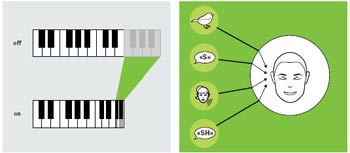
Summary
Frequency compression is an innovative solution to one of the most common challenges facing people with hearing impairment: poor perception of high frequency sounds. These high frequencies are generally in an area affected by cochlear damage1. This problem can cause:
- Difficulty in recognizing certain speech sounds, such as the fricative consonants /f/, /s/, and /sh/.
- Difficulty in hearing and identifying high-pitched environmental sounds, such as birdsongs, alarms, and some musical sounds.
- Difficulty, particularly for young children, in learning to produce speech sounds that contain mainly high frequencies.
- Difficulty, particularly for adults, in maintaining speech quality.
Being aware of these challenges, Phonak, in collaboration with the University of Melbourne, developed SoundRecover, an innovative non-linear frequency compression algorithm. It compresses selected high frequency sounds into a lower frequency range where both hearing sensitivity and discrimination ability are better. The proprietary algorithm effectively extends the audible range without creating any annoying artifacts. Frequencies below the compression knee point are amplified conventionally while only the high frequencies are compressed. The initial frequency compression setting is automatically calculated by the fitting software for each wearer and can be easily fine tuned if needed. Many hearing impaired people with poor high frequency discrimination will benefit from the intelligent SoundRecover algorithm.
Introduction
The majority of people with hearing impairment experience greater difficulty hearing sounds at high frequencies than at low frequencies. Traditionally, the greater the hearing loss, the more gain needs to be applied at that frequency. However, for some people, hearing sensitivity is so poor in the high frequencies that it is not possible to provide sufficient gain and achieve audibility. In many cases, the gain is limited by acoustic feedback or by discomfort, resulting from excessive loudness. Furthermore, even when sounds can be made audible, they may not be discriminated or recognized. Such perceptual problems are often a consequence of irreversible damage to the hair-cell receptors in the inner ear.
What happens when high frequencies are inaudible?
Many sounds essential for speech understanding have high frequency components. For instance, as shown in Figure 1, the consonant /s/ has almost all its energy confined to a high frequency range with a peak at 8 kHz or higher8. Difficulty with hearing or discriminating fricative consonants such as /s/ can seriously impact speech intelligibility, particularly in challenging listening situations. In English, for example, the consonant /s/ occurs very often, playing a critical role in enabling listeners to distinguish between singular and plural nouns, contractions (it's), 3rd person present tense, present vs. past tense, and possessive pronouns. For children learning speech and language, the ability to hear all phonemes and to discriminate effortlessly among all consonants and vowels is crucial.
Speech comprehension is not the only ability adversely affected by high frequency hearing impairment. Many other types of sounds, such as birdsongs, alarms, doorbells, and telephone ring tones, can be hard to detect or identify. Some of these sounds are valuable mainly because they enhance the quality of a person's overall experience of hearing. Others may be significant in a practical sense, including the security of being able to quickly and easily recognize high-pitched alarms.
As conventional amplification does not provide sufficient high frequency amplification, other methods need to be taken into account. Frequency shifting is one solution that has been discussed in the literature for many years.
Various frequency shifting algorithms have been developed over the years. When comparing the different approaches, large differences in implementation, resulting sound quality and potential speech understanding benefit are apparent. Most past attempts atfrequency shifting are best described as frequency transposition.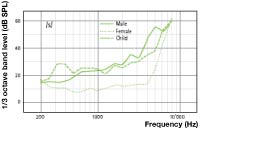
Figure 1. One-third octave band spectra for /s/ spoken by adult male, adult female, and child (reproduced with permission from Stelmachowicz, Pittman, Hoover, Lewis and Moeller,
20049).
In general, previous processing schemes can be divided into a few categories based on three criteria:
- Are all frequencies shifted, or only a selected range of frequencies?
- Does frequency shifting occur all the time, or only under certain conditions?
- Do the shifted frequencies overlap with the unshifted frequencies?
One relatively early frequency transposition scheme (Figure 2) operates by detecting whether the incoming signal is above or below a particular high frequency4, 5. If the signal is above this frequency, it activates the frequency transposition and shifts all frequencies within the amplified sound. One weakness of this scheme is that high frequency inputs are difficult to detect reliably, especially in situations with competing noise. Furthermore, enabling and disabling the transposition can produce distracting artifacts that are audible to some hearing instrument users.
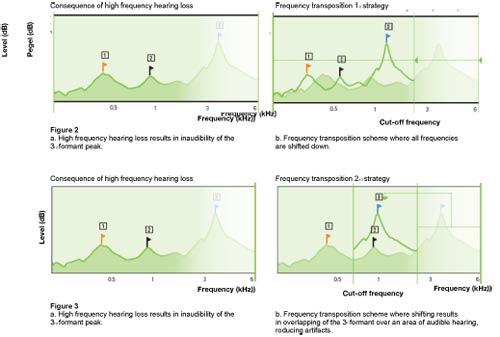
A more recent frequency transposition scheme (Figure 3) identifies a range of high frequencies to be shifted downward2, 3. This downward shift, which may only occur under certain conditions or can be present all the time, results in the transposed high frequency range overlapping with the lower frequencies present in the input signal. This can produce artifacts such as blurring of vowel sounds in the overlapping region, impacting sound quality.
SoundRecover: A new and unique solution to achieve high frequency audibility
SoundRecover, introduced by Phonak in the UltraPower model Naída, provides an excellent and unique non-linear frequency compression. With SoundRecover, a selected range of high frequencies are progressively compressed into a narrower range (Figure 4). The non-linear frequency compression algorithm moves the sounds to an adjacent area with less cochlear damage, where they can be processed and amplified. SoundRecover successfully improves high frequency perception while avoiding the production of annoying artifacts.
Specifically:
- SoundRecover is active all the time.
- A preselected range of high frequencies is compressed, based on the listener's hearing loss.
- No special frequency analysis of incoming signals is required.
- The frequency compressed output signals do not overlap with lower frequencies.
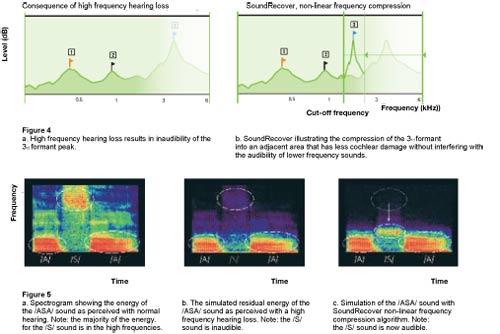
Figure 5a shows the temporal distribution of the /ASA/ sound with the majority of the energy for the /S/ sound in the high frequencies.
Figure 5b shows a simulation of the residual energy of the /ASA/ sound perceived by someone with a high frequency hearing loss. The majority of the energy for the /S/ sound is inaudible.
Figure 5c shows a simulation of the /ASA/ sound when amplified with SoundRecover. Note that the high frequency components are compressed to an audible range and that global relations between different frequency components are preserved.
Figure 6 shows why we call this this type of sound processing non-linear frequency compression. The overall range of output frequencies is narrower than the range of corresponding input frequencies. Input frequencies up to a defined knee-point (called the cut-off frequency) do not undergo any frequency compression. Above the cut-off frequency, frequency compression is applied in increasing degrees to higher input frequencies. The amount of compression is limited to ensure that compressed frequencies do not interfere with the frequencies below the cut-off. This also ensures that artifacts are minimized and a clear sound quality is maintained.
Although the shape of the graph in Figure 6 is similar to that of an amplitude-compression function, it is important to keep in mind that the axes refer to frequencies, rather than levels. The shape of the non-linear frequency-compression function, and therefore the effect on the listener's perception, can be controlled by adjusting two parameters: the cut-off frequency and the compression ratio.
The effect of changing these parameters is illustrated with two examples in Figure 7. Curve (a) shows a high cut-off frequency (3 kHz) and a relatively high compression ratio. This results in processing that affects only the highest input frequencies, although the degree of frequency compression across that frequency range is large. Settings such as these might be suitable for a person having only moderate hearing impairment at high frequencies and less impairment at lower frequencies. Curve (b) in Figure 7 shows a lower cut-off frequency (1.5 kHz) and a lower compression ratio. This results in a lesser degree of frequency compression being applied over a wider range of frequencies. Such settings would be more appropriate for a person with relatively severe hearing impairment across a wide range of frequencies.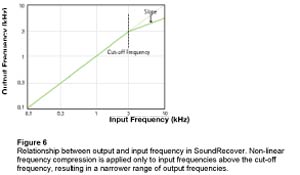
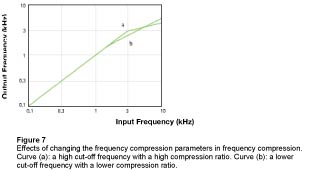

You can clearly see in the speech spectrograms above (Figure 8) that regardless of the amount of compression applied, the frequency compressed output signals do not overlap the low frequency range and the global relations between different components remain intact.
Fitting SoundRecover
For Naída UltraPower devices, SoundRecover is enabled and configured automatically in iPFG, based on the entered audiogram and the chosen prescriptive formula. It can also be easily modified to optimize fitting benefits. As children have different fitting requirements compared to adults, it seemed logical to have two distinct strategies for optimizing the settings to both children and adults.
Adults
For these users, both the hearing levels at specific frequencies and the slope of the audiogram across frequencies are taken into account. For calculation of the cut-off frequency, relatively high frequencies are selected, if the hearing impairment is mild or the audiogram is flat. Lower cut-off frequencies are selected for more severe levels of impairment or for audiograms with relatively steep slopes. The frequency compression ratio is then derived from the cut-off frequency. The compression ratio effectively determines the strength of the frequency compression processing above the cut-off frequency. For example, large compression ratios result in a stronger degree of frequency compression, because a wider range of input frequencies is compressed into a given range of output frequencies. The automatic target setting in iPFG selects larger ratios, and therefore a stronger frequency compression effect, for higher cut-off frequencies.
Children
SoundRecover technology has the potential to improve the quality of life for many children with hearing loss by helping to provide audibility of the full speech spectrum and enhancing the listening experience. SoundRecover can help minimize delays in speech and language development by attempting to provide a greater usable bandwidth of speech sounds;over and above what is available with conventional amplification. A non-linear frequency compression algorithm setting is generated for pediatric fittings which closely approximates the algorithm obtained by the research conducted at the University of Western Ontario by Scollie, Glista and Bagatto (to be published). In this study, improved speech recognition was observed for the majority of child participants. The pediatric fitting application generates a SoundRecover frequency compression prescription based on the entered audiogram and the DSL v5 prescriptive formula. Specifically iPFG will calculate the frequency compression cut-off frequency and compression ratio values by selecting the better ear thresholds per audiometric frequency and calculating the high frequency pure tone average (HF-PTA) using 2-4 kHz. The final HF-PTA value is then used to predict initial cut-off frequency and compression ratio values. In general, the more severe the hearing loss, the stronger the frequency compression setting. The goal of this hearing instrument fitting approach is to provide maximum audibility of speech cues while taking into consideration listening preferences and requirements specific to children.
Overall benefits
The SoundRecover non-linear frequency compression algorithm was developed and verified in extensive clinical trials in Australia with severe to profound hearing loss users 6, 7. There have also been extensive field studies* with adults and children in Canada and Germany that have shown the many benefits of SoundRecover: Increased detection, distinction and recognition of sounds. Significant improvement in intonation and overall voice quality. Improved hearing of high-pitched sounds and better speech understanding (most noticeable for high-pitched talkers such as women and children, softly spoken people, or high frequency sounds such as /s/ or /f/). Reduced feedback.
*The hearing instruments used were product prototypes and the results might show a slight deviation in comparison to the final product.
Conclusion
SoundRecover enables audibility of high frequency sounds that are otherwise inaudible. Understanding of certain speech sounds, such as fricative consonants, is enhanced, especially in challenging acoustic environments. For children, SoundRecover ensures that a greater number of high frequency cues are available aiding in the development of speech and language skills and continued audibility of important speech sounds throughout schooling. SoundRecover is the most important breakthrough in power amplification since the move from body-worn to behind-the-ear instruments!
Phonak would like to acknowledge Prof. Hugh McDermott (University of Melbourne) and Danielle Glista (University of Western Ontario) for their help in the creation of this document.
References
- Moore, B.C.J. Dead regions in the cochlea: Conceptual foundations, diagnosis and clinical applications, Ear Hear. 25: 98-116 (2004).
- Kuk F. Critical Factors in Ensuring Efficacy of Frequency Transposition. Retrieved from www.avrsono.com
- Kuk, Korhonen, Peeters, Keenan, Jessen und Andersen. (2006). Linear frequency transposition: Extending the audibility of high frequency information. The Hearing Review, October. Retrieved from www.hearingreview.com
- McDermott, H.J., V.P. Dorkos, M.R. Dean und T.Y. Ching, Improvements in speech perception with use of the AVR TranSonic frequency-transposing hearing aid. J Speech Lang Hear Res, 1999. 42(6): p. 1323-35
- McDermott, H.J. und M.R. Knight, Preliminary results with the AVR Impact frequency-transposing hearing aid. J Am Acad Audiol, 2001. 12(3): p. 121-7.
- Simpson, A., A.A. Hersbach und H.J. McDermott, Improvements in speech perception with an experimental nonlinear frequency compression hearing device. International Journal of Audiology, 2005. 44(5): p. 281-92.
- Simpson, A., A.A. Hersbach und H.J. McDermott, Frequency-compression outcomes in listeners with steeply sloping audiograms. International Journal of Audiology, 2006. 45: p. 619-629.
- Stelmachowicz, P.G. Pediatric Amplification: Past, present and future. In Phonak Hearing Systems 3rd Pediatric Conference. 2004. Chicago, USA.
- Stelmachowicz, P.G., Pittman, A.L., Hoover, B.M., Lewis, D.E. und Moeller, M.P. (2004). The Importance of High Frequency Audibility in the Speech and Language Development of Children with Hearing Loss. Archives of Otolarygology - Head & Neck Surgery, 130, 556-562.
For more information, please visit www.phonak.com or the Phonak Web Channel on Audiology Online.

